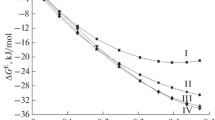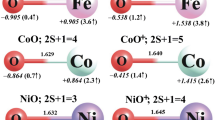Abstract
The relation between the molar volume of metal oxides and their composition has been discussed. In order to compare molar volume of oxides with different compositions, the volume per one mole of oxygen atoms (Ma/bO) was used. It has been found that molar volumes of oxide phases of the same metal in the composition range 2 > a/b > 0.5 are linear functions of composition. This type of relationship has been proposed as an additional criterion to classify an oxide as a compact structure. Furthermore, in the case of oxides with metal ions in higher oxidation states (Mz+ > M4+) the increase of the molar volume (relative to the MO2 oxides) and the formation of framework structures have been found.
Graphical Abstract
Molar Volume and Composition of Oxides of the Same Metal
Andrzej Stokłosa*, Barbara Laskowska
Molar volumes of oxide phases of the same metal in the composition range 1>a/b>0.3 are linear functions of composition.

The dependence of the effective molar volume (Veff) of the oxides Ma/bO on the composition (a/b) for the transition metal oxides and Ce oxides




Similar content being viewed by others
References
Goldschmidt VM (1931) Fortschr Mineral 15:73
Pauling L (1927) J Am Chem Soc 49:765
Zachariansen WH (1931) Phys Rev 37:775
Ahrens LH (1953) Geochim et Cosmochim Acta 2:155; (1953) 3:2
Shannon RD (1976) Acta Cryst A 32:751
Shannon RD, Prewitt CT (1969) Acta Cryst B 25:925; (1970) 26:1046
Biltz W (1934) Raumchemie der festen Stoffe. Verlag von Leopold Voss, Leipzig
Wells AK (1990) Structural inorganic chemistry. Clarendon Press, Oxford
O`Keeffe M, Navrotsky A (eds) (1981) Structure and bonding in crystals. Academic Press, New York
Adams DM (1974) Inorganic solids, an introduction to concepts in solid state structural chemistry. Wiley, London
Rao CNR, Raveau B (1995) Transition metal oxides. VCH Publ., New York
Stokłosa A, Laskowska B (2007) High Temp Mat Process 26:93
Landolt-Börnstein (1975) Crystal structure data of inorganic compounds. Springer-Verlag, Berlin, III, 7b
Powder diffraction File, PDF-2. International Center for Diffraction Data. Newtown Square, ICDD 2003. PA 19073-3273, USA
Von Meerssche M, Dupont JF (1976) Introduction à la cristallographie et à la Chimie structurale. OYEZ, Luven
West R (1996) Basis solid state chemistry. J. Wiley, Chichester
Author information
Authors and Affiliations
Corresponding author
Rights and permissions
About this article
Cite this article
Stokłosa, A., Laskowska, B. Molar Volume and Composition of Oxides of the Same Metal. J Chem Crystallogr 38, 279–284 (2008). https://doi.org/10.1007/s10870-007-9296-4
Received:
Accepted:
Published:
Issue Date:
DOI: https://doi.org/10.1007/s10870-007-9296-4




